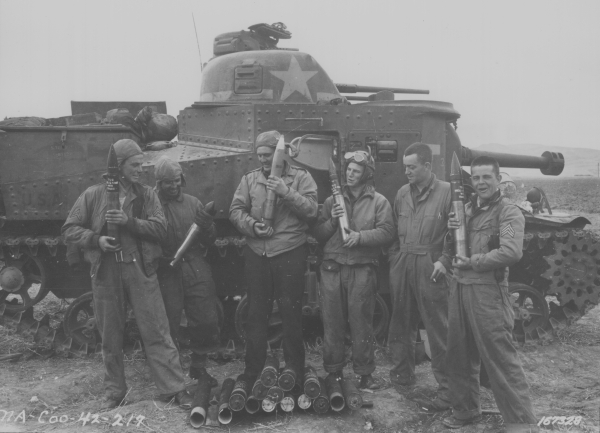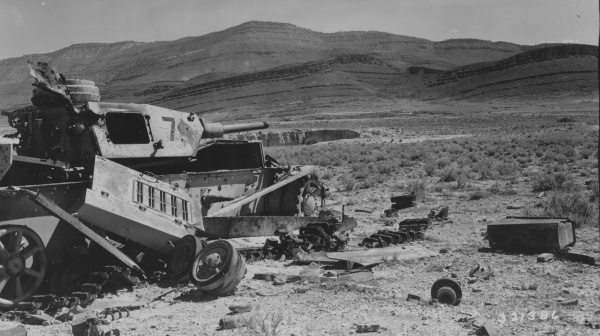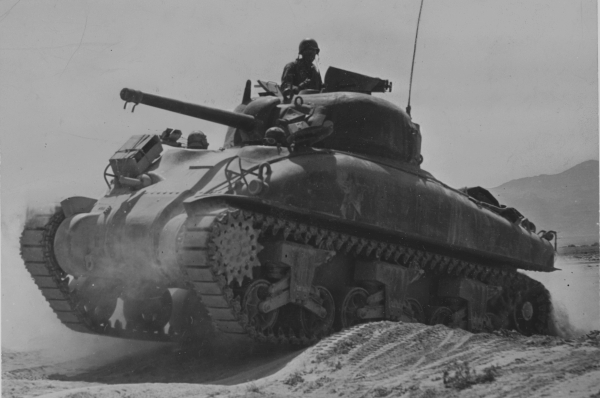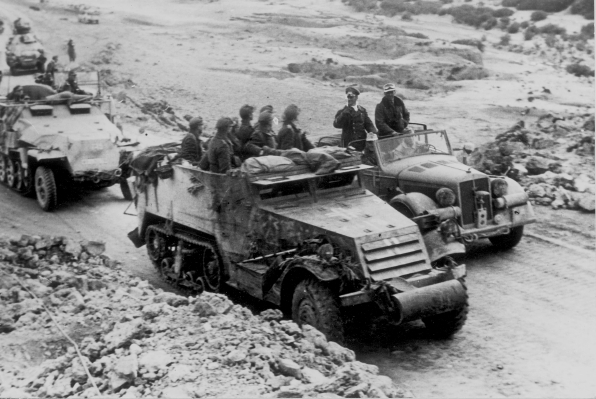
“All battles,” the historian John Keegan once observed, “are in some degree disasters.”
The Battle of Kasserine Pass—actually a series of battles in February 1943 when raw American troops had their first major battlefield encounters with the German army—has long ranked as one of the worst disasters ever suffered by the United States Army. Inexperienced and nervous GIs, overwhelmed and beset by rumors and chaos, abandoned their positions, destroyed their supplies, clogged roads in headlong flight, or simply melted away in the night. In 10 days, panicked American forces were hurled back 50 miles, losing 183 tanks and nearly 7,000 men, including 300 killed and 3,000 missing.
“Even these many years later,” General Omar Bradley wrote shortly before his death in 1981, “it pains me to reflect on that disaster. It was probably the worst performance of U.S. Army troops in their whole proud history.” To Americans back home, wrote historian Martin Blumenson, “the event was incredible. It shook the foundations of their faith, extinguished the glowing excitement that anticipated quick victory, and, worst of all, raised doubt that the righteous necessarily triumphed.”
But even victories can be failures, and Kasserine was also a catastrophic lost opportunity for the Germans, a point barely realized at the time and even today not always fully appreciated. At Kasserine, the once seemingly invincible panzer commander Erwin Rommel—tired, ill, vexed by the second-guessing of Hitler and rival officers—showed himself hesitant and indecisive, squandering the German army’s last real hope for retaining its foothold in North Africa.
Two weeks after what would be his last battlefield victory of the entire war, Rommel, weakened with jaundice and thoroughly demoralized, bade a tearful farewell to his staff and boarded a plane for a long-postponed “health cure,” declaring that to try to hold on in Africa was now “plain suicide.” Had he boldly continued east to strike at the Allies’ huge supply depot in Algeria, the course of the war might have been changed. But as it was, his triumph at Kasserine would prove only a brief respite for the Germans in an unstoppable Allied tide that would hurl the Axis out of Tunisia a scant two months later, clearing the way for the Allied invasion of Italy that summer.
The experience would also affirm the enduring American genius for confronting mistakes and profiting even from catastrophe. Postmortems of the battle would show that the defeat had less to do with a lack of training—or as America’s more experienced British allies all too quickly asserted, a lack of will to fight by the cocky, green, and overconfident Americans—than with fundamental flaws in battle doctrine, command, and organization.
Many American units in fact fought with astonishing bravery against incalculable odds, and within weeks the U.S. Army would institute sweeping organizational and tactical changes—particularly in air support and armor fighting doctrine—that would erase the stain of Kasserine with a string of decisive victories.
The British charge that Americans were cocky, green, and lacked fighting spirit was not baseless. The prevailing attitude among GIs, one American officer admitted, was that the entire North African campaign was “just another maneuver with live ammunition.” The lightly opposed landings in Algeria in November 1942 in Operation Torch, during which some 107,000 American troops met only token resistance from Vichy French forces (who then quickly surrendered and switched sides), had created widespread overconfidence and a sense of inevitable victory. “We were very sure of ourselves—too sure,” recalled one lieutenant, a forward observer in the artillery fresh out of Yale ROTC. “Nothing could stop us. We knew everything about how to smash the Nazis.”

They also had an unrealistic sense of how long the job was going to take, wrote New York Times correspondent Drew Middleton: “Officers and men alike viewed the capture of Maison Blanche and Algiers as a sort of football game. Many appeared to feel that once these two objectives were taken, the season was over, and they would go home.”
National Guard units, which formed the core of the 34th Infantry Division that would find itself at the center of the Kasserine debacle, lacked basic soldiering and survival skills in those first weeks. The peacetime Guard units were more like fraternal clubs than military organizations, and their officers and men were, as Martin Blumenson observed, “physically soft and undisciplined,…ignorant of field manuals, unable to reconnoiter properly, and generally deficient in basic and small-unit training.” Many GIs arrived in Tunisia not knowing how to use the weapons they were supplied (notably bazookas and mines), how to secure their flanks, procedures for identifying friend and foe, or how to fight at night.
Even as simple a skill as taking cover had to be learned the hard way under live fire, especially fire from aircraft. Training in a drill hall was one thing; being strafed by a Messerschmitt was another. (In a letter to his wife, George S. Patton described the procedure that everyone soon learned: “If you see the plane in time you stop the car and run like hell for 50 yds off the road and lay down. It seems most undignified but all do it.”)
Still more grim was the lesson American soldiers had to learn about the inadequacy of slit trenches. A slit trench was basically a shallow depression just deep enough for a man to stretch out full length in, with his body just below ground level. It provided cover against machine gun fire and shells fused to burst on ground impact. But for air bursts or strafing from aircraft, slit trenches were “plain murder,” one young officer recalled. “We had to learn that by experience, too…when Rommel’s tanks came rolling through. Those tank drivers loved slit trenches with Americans in them. They would run their treads right into the trench, then half turn—like a meat grinder….It couldn’t have happened if they had been in fox holes.” It was “tiresome and a damned nuisance to dig a hole for yourself every time you stop for five or ten minutes,” the lieutenant continued—and even more of a nuisance to dig a shoulder-deep foxhole—but as he and his fellow GIs recognized, “it’s a lot more fun being tired and alive than rested and dead.”
In mid-December 1942, reacting swiftly to the American landings, Hitler rushed forces from Sicily to the key ports at Tunis and Bizerte in northeastern Tunisia. By January, 100,000 men of the 5th Panzer Army under General Hans-Jürgen von Arnim had landed along with a formidable Luftwaffe force of Messerschmitt fighters and Stuka dive-bombers. Meanwhile, Rommel’s Panzerarmee Afrika, executing a skillful fighting retreat across Libya ahead of the British Eighth Army, was entering Tunisia from the south.
The Allies occupied the western half of the country and held a thinly defended line atop a north-south chain of mountains, the Eastern Dorsal, that divided the country nearly in two. Lacking sufficient forces to yet take the offensive, General Dwight D. Eisenhower canceled a proposed plan to send an armored column driving east to the ocean to cut the coastal plain in two and stop the two German armies from linking up; instead he ordered the arriving American force, II Corps, to bolster French and British defenses of the passes of the Eastern Dorsal and meanwhile carry out raids to keep the enemy off balance until the time was ripe for a full-scale offensive.

In the predawn darkness of January 30, 30 panzers broke through Faïd Pass, in the center of the Eastern Dorsal, and struck a force of 1,000 poorly equipped French infantry. A second panzer and infantry force looped 10 miles to the south and came up from behind, encircling the beleaguered defenders.
A desperate appeal by the French for help was answered by a woefully small American armored task force from the 1st Armored Division commanded by a gentlemanly ex-
cavalry officer, Brigadier General Raymond McQuillin. Even his admirers called him “Old Mac.” McQuillin spent the better part of the day cautiously creeping forward, then at mid-afternoon—seven miles from Faïd—he decided to halt for the night and put off his counterattack until the following morning.
The next day, his piecemeal force of 17 Sherman tanks went driving forward, directly into the glare of the rising sun, and right into a trap: German 88mm guns opened up from concealed positions on the western approaches of the pass, and within 10 minutes the attack was a shambles, 9 of the tanks ablaze. An equally abortive infantry counterattack failed the next day, leaving the crucial pass firmly in German hands.
Recriminations flew; the French, who lost 900 killed and missing, were furious over the American ineptitude.
American soldiers, especially infantrymen, were undoubtedly deficient in training and experience. But there was more to it than that. The tankers of the 1st Armored Division had spent the summer in Ireland undergoing as tough and realistic a training regimen as any armored force in the world. Tank crews honed their skills firing on moving targets, maneuvering in rain and mud and on steep mountainous trails, and coordinating with artillery. The division had also participated in the two large-scale U.S. Army maneuvers in 1941 in Louisiana and the Carolinas. It was, as one recent U.S. Army study notes, an “unprecedented level of predeployment training.” The real problem with the performance of the Americans in their first encounters with Rommel’s panzers was not that the 1st Armored Division was badly trained, the study concluded, but that it was “reasonably well trained in the execution of a fatally flawed doctrine.”
The U.S. Army fundamentally misconceived the role of the tank in modern combined arms warfare, a misconception reinforced by a misreading of the lessons of the German blitzkrieg across France in 1940. American doctrine called for tanks to dash ahead and break into the weakly protected enemy rear, much in the fashion traditionally played by cavalry. The primary responsibility for neutralizing the enemy armor would meanwhile fall to “tank destroyers,” quasi-independent battalions equipped with 37mm or 75mm guns mounted on lightly armored trucks or half-tracks. American tank crews were confidently assured that on the modern battlefield, tanks would not fight other tanks, and that speed was more important than close coordination with infantry and artillery.
Compounding this defective doctrine, the Americans were led by fatally flawed commanders, none more so than Major General Lloyd R. Fredendall, the commander of II Corps. Fifty-nine years old, opinionated, impatient, “inclined to jump to conclusions” in the words of his fellow general Lucian Truscott, Fredendall had distinguished himself as an able teacher and administrator in World War I and the interwar years, but had never led troops in combat.
Fredendall was given to sloganeering pronouncements and tough-guy slang that poorly concealed his own muddled thinking and imprecision, barking out orders like “Go smash ’em,” “Go get ’em at once,” “Knock the shit out of the Italians,” “Pull a Stonewall Jackson,” “Use your tanks and shove”—then erupting in fury if a subordinate dared ask for clarification.

He scarcely visited the front but was a compulsive micromanager, dismissing intelligence reports, bypassing division and brigade commanders, and ordering exact dispositions of units down to the company level. For weeks he had 200 engineers digging and blasting and pouring concrete to construct a vast bombproof bunker for his “command post,” 100 miles to the rear up an inaccessible canyon near Tebessa, Algeria. This monument to his own safety was, Bradley later said, “an embarrassment to every American soldier.”
Fredendall repeatedly ignored both suggestions from above by Eisenhower and pleas from below by the commander of the 1st Armored Division, Major General Orlando Ward, to keep the armored force concentrated as a single mobile reserve that could counterattack in force to repulse any new German thrust to the west from the Eastern Dorsal passes. Instead, trying to guard against every possibility while in fact protecting against none, he had the 1st Division’s tanks spread out over an 80-mile front in small units, and further paralyzed the force by imposing a byzantine command structure: Ward had direct control of only a fraction of his own division.
Just before midnight on February 13, General Eisenhower arrived at the tiny crossroads town of Sidi bou Zid to inspect units of the 1st Armored Division and the 34th Infantry Division, which had been ordered there to shore up the defenses west of Faïd following the German capture of the pass on January 30. In his memoirs, Eisenhower would write that he had been disturbed by what he saw but that it would not have been proper for him to interfere in tactical decisions of the commander on the spot.
In fact, there had already been nothing but interference from on high and far off—by Fredendall, who had issued orders to Ward specifying where to place his men and tanks, how to employ artillery and conduct patrols, even where to string wire and place mines. Obvious to everyone but Fredendall—and especially obvious to the soldiers on the scene—was that as good as they might look on a map at headquarters, the dispositions were all wrong.
Fredendall had specifically instructed Ward to hold two isolated hills that flanked the road leading from the pass, with an infantry regiment and a company of tanks at each. Two more tank companies were to be held as a small reserve back at Sidi bou Zid. But the hills were too far apart to allow the forces to support one another and were likely to be simply encircled and cut off if the Germans attacked, freezing the defenders in place.
That was precisely what happened. At 6:30 the next morning, 100 panzers boiled through the pass, then split into two columns that swiftly enveloped Djebel Lessouda, the northern of the two hills.
McQuillin, in command of the tank battalion at Sidi bou Zid, ordered a counterattack that perfectly underscored the impossibility of substituting bravery for sound doctrine. Compounding the operational blunder of sending one unit of an armored division into combat piecemeal, and uncoordinated with the division’s own infantry and artillery, the Americans’ charge was a tactical travesty. The American column of 50 tanks and tank destroyers rushed courageously right into the oncoming panzer force. Its three dozen Sherman tanks had a significant firepower advantage over the German Panzer IIIs: their 75mm shells could pierce the German tanks at 1,500 yards, three times the effective distance of the Germans’ smaller 50mm guns. But instead of using the tank’s inherent mobility to maneuver, flank, use cover and concealment, and outposition the enemy—and thus exploit that firepower advantage—the Americans came on full speed in tight parade-ground formation.

On Djebel Ksaira, the southern hill, Colonel Thomas D. Drake watched the American attack crumble as Sherman after Sherman burst into flames, the survivors desperately reversing gear as they scrambled for safety. His men also saw what was happening. Reaching McQuillin on a field telephone, Drake reported that McQuillin’s troops were deserting their positions and he was losing his artillery support.
“You don’t know what you’re saying,” McQuillin insisted. “They’re only shifting positions.”
“Shifting positions, hell,” Drake replied. “I know panic when I see it.”
But before long another voice came over the phone with a message from McQuillin’s headquarters: “General McQuillin is pulling out and you are to stay here.” Then the line promptly went dead.
A hastily summoned relief force of another tank battalion from the 1st Armored Division arrived the next afternoon and met the same fate as it tried to rescue 1,900 infantrymen still holding out on Djebel Ksaira and a nearby ridge. Again, the German tank crews were astonished at the Americans’ failure to spread out and maneuver, simply picking them off one after another. Of the 52 American tanks that went into the attack, 46 were destroyed or abandoned.
After night fell, the trapped infantry units tried to make their way westward to safety as best they could, through the German forces that now completely surrounded them. Only a few hundred made it. Drake and all but one of his officers—and more than 1,400 of his men—were captured.
The American collapse at Sidi bou Zid determined everything that followed in the days of panic that spread west. Fredendall continued to muster piecemeal counterstrokes that were swallowed up in succession by Rommel’s juggernaut. By the evening of February 20, the lead units of Rommel’s Afrika Korps had pushed through the passes around Kasserine that controlled the roads north and west. Major General Ernie Harmon, commander of the 2nd Armored Division, was hastily ordered by Eisenhower to take charge of the unfolding disaster and restore the situation. He encountered a nightmarish scene on his 100-mile drive to the front as he and his aide were repeatedly run off the road by troops fleeing the other way.
“It was the first—and only—time I had ever seen an American army in rout,” Harmon later wrote. “Jeeps, trucks, wheeled vehicles of every imaginable sort streamed up the road toward us, sometimes jammed two and even three abreast. It was obvious there was one thing only in the minds of the panic-stricken drivers: to get away from the front, to escape to some place where there was no shooting.”
To follow up the German success, the 5th Panzer Army’s von Arnim now wanted Rommel to head north to Le Kef, which would hit the flank of the British First Army located in the north of Tunisia. Rommel favored a quick, bold strike west against Tebessa and its huge supply depot, which the entire Allied force depended upon, and requested that the 10th and 21st Panzer Divisions be added to his force.
Now it was the Germans’ turn to fall to bickering and indecision. Rommel would later blame everyone but himself, and when he finally received orders giving him the divisions but including Le Kef as one of his general objectives, he called it an “unbelievable piece of shortsightedness.” The truth was that the orders were sufficiently ambiguous to let him proceed as he said he wished.
But the days of delay spent arguing with von Arnim—and perhaps a growing sense of the ultimate futility of the German army’s position in Africa after months of retreat— seemed to have taken their toll on Rommel’s confidence. With an abundance of caution so unlike his reputation, Rommel proceeded to violate one of the most basic precepts of warfare by dividing his force in three: the Afrika Korps continuing west, the 10th Panzer Division north to Le Kef through the Kasserine Pass and the town of Thala, and the 21st on a parallel route to Le Kef 20 miles to the east through Sbiba. The delay and splitting of his resources gave the British and Americans time at last to throw powerful artillery forces into the breach, halting Rommel on all three axes of his advance.
On the afternoon of February 22, Field Marshal Albert Kesselring, the commander in chief of all Axis forces in the Mediterranean, met with Rommel at his field command post at Kasserine Pass and found him unusually dispirited: “His heart was not in his task and he approached it with little confidence,” Kesselring noted. Both agreed that the offensive was spent and withdrawal was now the only option.
For his Pyrrhic victory Rommel was awarded command of all Axis forces in Tunisia. By contrast, the Americans’ humiliation galvanized them into swift and sweeping reforms. The dysfunction and the squabbling of the German army command stemmed directly from Hitler’s feudal leadership style; in the U.S. Army the failure at Kasserine was much more simply the result of incompetent individuals, and Eisenhower hesitated only briefly before heads rolled. Fredendall was replaced by Patton as II Corps’ commander, McQuillin and several other senior tank and infantry officers were relieved of command (as was Eisenhower’s intelligence officer), and the convoluted command structure was straightened out.
More importantly, the book on tank doctrine was thrown out the window. A report by General Harmon on the lessons of the Tunisian campaigns underscored the need for tanks, artillery, and infantry to closely coordinate their maneuvers, to maintain constant radio communication, and to act methodically—to forget “the false training idea” of sending tanks “boiling down the road” to contact the enemy, the practice that cost so many tanks and casualties at Sidi bou Zid.
Air support procedures were also completely overhauled within days of the Kasserine debacle. The Americans adopted the extremely successful British model pioneered by Air Marshal Arthur Coningham, ensuring air power was coordinated with ground action—something appallingly absent during the Kasserine operations. They also ensured that air forces were not frittered away on static defenses or on
endless demands by ground units for their own personal “air umbrellas.”
Eisenhower personally took responsibility for allowing the fatally flawed dispersal of American forces; it was, Rick Atkinson observed, one of Ike’s virtues that he “studied his mistakes.” The “principle of mass”—Clausewitz’s dictum to synchronize and bring to bear all elements of a combat force for decisive effect—was one of the most elementary textbook lessons a commander learns, but there was nothing like a real-world drubbing to bring a point home. It was the Battle of Sidi bou Zid “which underlined in the most practical manner possible the oft repeated axiom that an armored division must always be used en masse,” wrote an officer of the 1st Armored Division in a report for the Army’s official history. “Thereafter, in the American Army, it always was.”
Stephen Budiansky is a former national security correspondent, deputy editor, and foreign editor of the weekly news magazine U.S. News & World Report and the former Washington editor of the scientific journal Nature. Budiansky has written extensively on military history and foreign affairs. His latest book is Perilous Fight: America’s Intrepid War with Britain on the High Seas, 1812–1815 (Knopf).




